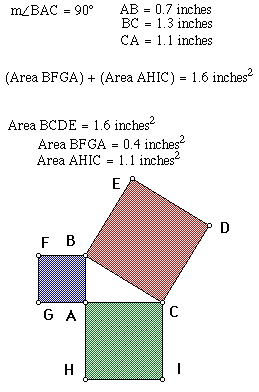Day 7: Pythagorean
Theorem
by
Richard Moushegian
Objective: To
state and apply the Pythagorean Theorem and its converse
GA QCC: #24
Lesson: Pythagorean
Theorem
Name: ___________________________
HISTORICAL SUMMARY:
Pythagoras of Somas (located in Greece) lived
from about 569 to 475 BC. He is often described as the first pure
mathematician. We particularly remember him for a famous geometry
theorem that bears his name. Although the mathematical relationship
was known to the Babylonians about 1000 years earlier, Pythagoras
is credited for proving it. Pythagoras should also be credited
with reducing mathematics to the abstract. For example the number
2 may refer to the number of ships, houses, writing implements,
and coins of any denomination.The manipulations with the abstract
quantities (numerical representations) is valid for all the material
things for which it represents. Hence, in my opinion, Pythagoras
helped pave the way for modern algebra.
He was a world traveler (his travels
to Egypt helped his study of mathematics); political activist
(which caused him to get into numerous political scrapes including
being a prisoner on a foreign soil); philosopher (the world
and cosmos could be reduced to numbers, the world dynamics consisted
of opposites, successive reincarnation through different species,
and the brain is the locus of the soul); musician(an accomplished
lyre player who contributed mathematics to music theory and understood
the soothing power of music to the sick); and founder of two
mathematics schools: one in Samos, "The Semicircle of
Pythagoras" (which became political and exists to this day),
and the other school (devoid of politics) was a Mathematikoi Society
in Croton (now Italy) that is credited for outstanding contributions
in mathematics.
There are 6 major contributions/theorems attributed
to Pythagoras (or the Pythagoreans):
1. The sum of angles of a triangle equals
2 right angles, and the generalization of that theorem that addresses
the sum of interior and exterior angles of a polygon.
2. Proving the theorem about right triangles
in which the square of the hypotenuse equals the squares of the
other two sides.
3. Solving algebraic equations with geometry
such as

4. Discovering irrational numbers.
5. Discovering the 5 regular solids.
6. Even though Pythagoras thought the earth
was the center of the universe (typical at that time), he recognized
that (a) the orbit of the moon was inclined to the earth's equator,
and (b) the planet Venus was both the morning star and
the evening star in the sky.
For more detailed Pythagoras biography, CLICK HERE. (http://www-groups.dcs.st-and.ac.uk/~history/Mathematicians/Pythagoras.html,
retrieved August 11, 2000 from the World Wide Web)
PYTHAGOREAN THEOREM:
1. The Pythagorean Theorem tells us that, in
a right triangle, the square of the hypotenuse equals the
squares of the other 2 sides.
2. As a visual representation, study
the figure below:

Since angle BAC is a right angle, then
the smaller areas BFGA (blue) and AHIC (green) total 1.6 square
inches - the value of area BCDE, 1.6 square inches. This relationship
holds true as long as angle BAC is a right angle.
CLICK HERE if you wish to experiment on your own. Only change
the lengths of the two legs; do NOT change angle A.
3. As a mathematical representation,
the Pythagorean Theorem is usually expressed as

where c is the length of the hypotenuse of
the right triangle, a and b are the 2 other sides which are called
"legs" (of a right triangle).
4. Without reviewing the above material,
state the Pythagorean Theorem in your own words:
Answer:______________________________________________________
_____________________________________________________________
5. Problems:
a. If b=3 and c=5, what is a? a = ____________
b. If a=4 and b=  ,
what is c? c= __________
,
what is c? c= __________
c. If c=2 and a=1, what is b? b= ______________
d. A 25 foot ladder is leaning against the
wall. The base of the ladder is 10 feet from the wall. How far
up the wall will the ladder reach? (Draw a picture and label
it.)
Answer: ________________________
Go to Day 8
Return to Table
of Contents
